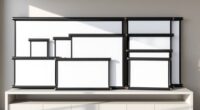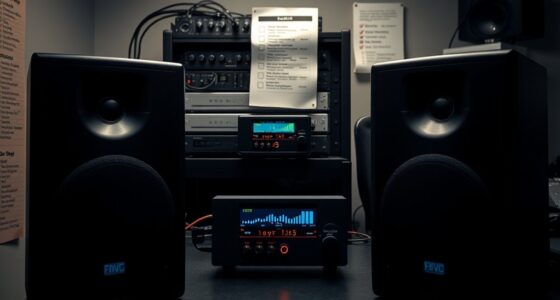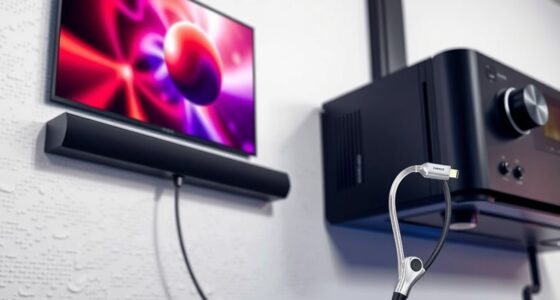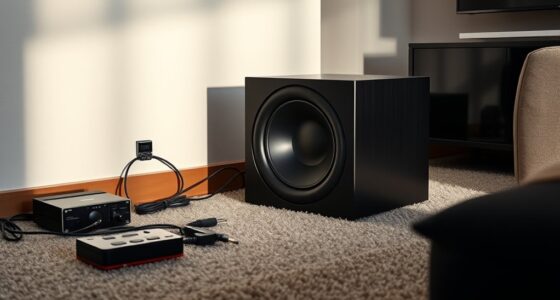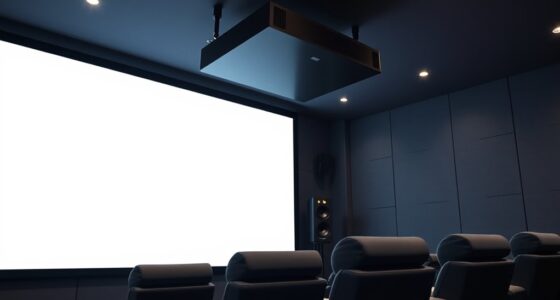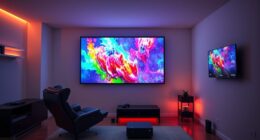To fix audio sync issues in your projector system, start by checking and adjusting the audio delay settings on the projector itself or your connected device, like a streaming box or Blu-ray player. Make small changes and test until the sound matches the video perfectly. If needed, tweak external speakers or soundbars for timing adjustments. Ensuring stable connections, updating firmware, and choosing the right audio format also help. Keep exploring different setups to achieve seamless lip-sync.
Key Takeaways
- Access the projector menu and adjust the “Audio Delay” or “Lip Sync” settings incrementally until audio matches video.
- Verify and reconfigure audio output settings on connected devices, enabling any available lip sync correction features.
- Check and tweak external sound systems or soundbars for built-in delay or sync adjustments.
- Prefer wired connections over wireless to reduce latency and improve synchronization stability.
- Update firmware on all devices and test different configurations for optimal audio-visual sync.
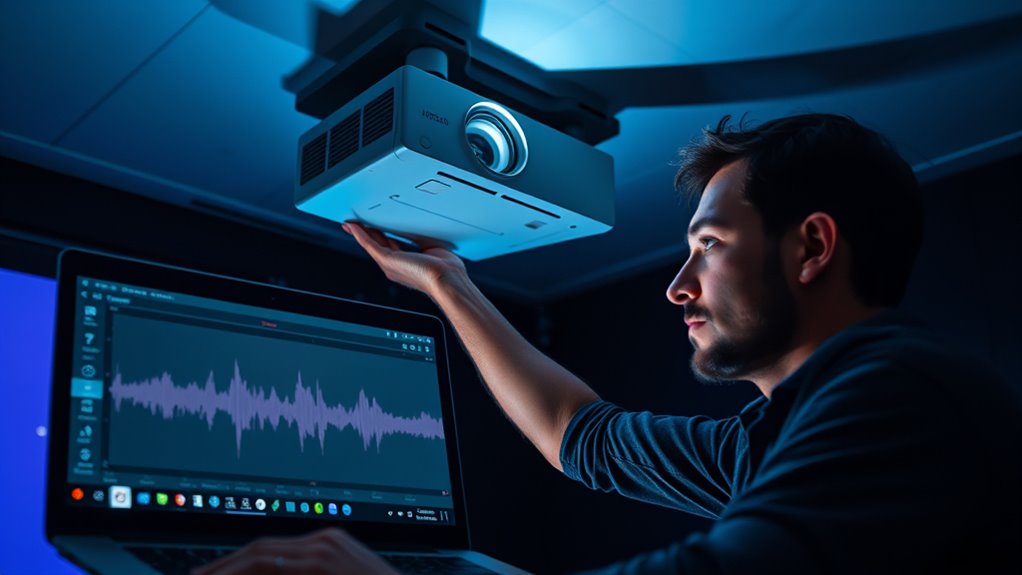
Audio sync issues in projector systems can be frustrating, but they’re often quick to fix with the right steps. If you notice that the audio isn’t matching the on-screen action, it’s likely due to an audio delay or synchronization challenges. These problems can stem from several sources, including the projector’s settings, the connected device, or the audio system itself. Understanding how to troubleshoot these issues will help you get back to enjoying your content without distraction.
First, check the audio settings on your projector. Many modern projectors have adjustable audio delay settings designed specifically for synchronization. Access the menu, locate the audio or sound options, and see if there’s a feature labeled “Audio Delay,” “Lip Sync,” or something similar. If you find it, try adjusting the delay incrementally. Sometimes, a small tweak of a few milliseconds can align the audio perfectly with the video. Keep testing until the lips match the speech or the sound aligns with the action on the screen. This is often the simplest and most direct way to resolve synchronization challenges caused by audio delay.
Adjust the projector’s audio delay or lip sync settings for quick, effective audio-visual synchronization.
If adjusting the projector’s internal settings doesn’t work, look at your connected devices. For example, if you’re using a streaming box, Blu-ray player, or gaming console, check their audio output settings. Many devices allow you to modify audio delay or output options, which can help eliminate the lag. For instance, enabling “lip sync correction” or adjusting the audio output format (such as switching between PCM and bitstream) can improve sync accuracy. Make sure your devices are running the latest firmware, as updates often fix bugs related to audio delay and synchronization challenges.
Another area to examine is your audio system, especially if you’re using external speakers or a soundbar. Some audio devices have their own delay settings or audio synchronization features. Consult the user manual to see if your equipment supports such adjustments. If it does, tweak the delay until the audio matches the video. In some cases, disconnecting and reconnecting cables or switching to different inputs can resolve minor sync issues caused by loose or faulty connections.
Finally, consider the overall signal path. Wireless connections, especially with Bluetooth or Wi-Fi, can introduce latency that causes audio delay. If possible, opt for wired connections or reduce wireless interference. Restart your devices after making adjustments, and test the playback again. Often, a combination of these steps will resolve your synchronization challenges quickly, restoring a seamless viewing experience. Remember, patience and small adjustments are key to fixing audio sync issues in projector systems. Additionally, understanding the contrast ratio of your projector can help you optimize image quality, which complements audio adjustments for a better overall viewing experience.
Frequently Asked Questions
Can Software Updates Improve Audio Sync Problems?
Yes, software updates can improve audio sync issues. They often include bug fixes and performance enhancements that reduce audio lag, ensuring better synchronization between sound and video. By keeping your projector system’s software current, you help prevent or resolve lip-sync problems, providing a smoother viewing experience. Regular updates are a simple yet effective way to address audio lag and maintain ideal audio-visual performance.
Is HDMI the Best Connection Type for Reducing Audio Lag?
Yes, HDMI is generally the best connection type for reducing audio lag because its high bandwidth supports better synchronization. To optimize performance, make certain you use high-quality cables, as inferior quality cables can introduce signal delay. Also, check device compatibility, since older devices or poor connections can cause lip-sync issues. Using a good HDMI cable with your compatible devices helps achieve minimal audio lag and smoother audio-visual sync.
How Does Room Acoustics Affect Audio Sync Accuracy?
Room acoustics considerably affect audio sync accuracy by influencing sound reflection and absorption. If your room has poor sound absorption, reflections can delay audio perception, causing lip-sync issues. Conversely, excessive sound absorption may weaken audio clarity. To improve sync, balance reflections with sound absorption materials like carpets or curtains, which reduce echo and delay, ensuring that audio aligns more precisely with the visual cues you see on screen.
Can Replacing the Projector’s Internal Components Fix Sync Issues?
Think of your projector’s internal components as the orchestra’s instruments; if one is out of tune, the entire symphony suffers. Replacing hardware can often realign the audio and video, fixing sync issues. By upgrading or swapping internal components, you restore harmony, ensuring your system’s timing is precise. Hardware replacement addresses the root cause, making your audio and visuals dance seamlessly together once again.
Are There Specific Brands Known for Better Audio-Visual Synchronization?
Some brands are known for better audio-visual synchronization, thanks to their strong brand reputation and manufacturer reliability. You should consider Epson and Sony, which consistently deliver high-quality projectors with minimal lip-sync issues. These brands invest in advanced technology, ensuring consistent performance and fewer sync problems. When choosing a projector, prioritize reputable brands to get reliable AV synchronization, reducing your need for troubleshooting and enhancing your overall viewing experience.
Conclusion
Now that you know the key steps to fix audio sync issues, don’t assume it’s always a simple fix. Sometimes, the problem runs deeper—possibly within your device’s hardware or software. As you tinker and test, be prepared for surprises that might challenge your patience. The solution could be just around the corner, or it might require a deeper dive. Stay vigilant, and remember—every fix brings you closer to seamless audio-visual harmony.

